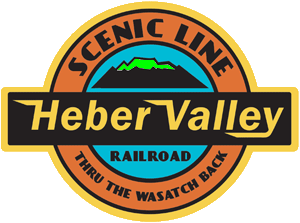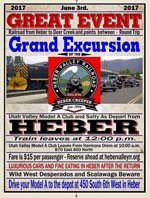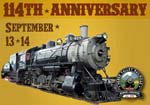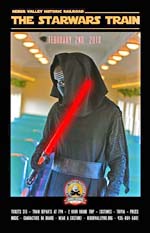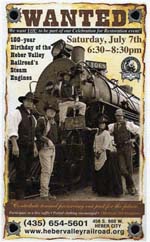RAILROAD
Heber Valley Railroad
Heber City Utah
United States of America
N40.502134 W111.424365

(Heber City Depot)
The Heber Valley Railroad first came to my attention shortly before the start of the 2002 Winter Olympics at Salt Lake City, Utah. It was mentioned that a locomotive from the Nevada Northern, another steam railway west of Salt Lake City, would be shipped to the Heber Valley to help pull trains to an Olympic ski site. This third engine would therefore make a steam locomotive triple-header possible along the Heber Valley Railroad's route.
A triple-header in the clear cold air of the valley with fresh snow reflecting the light would have yielded some spectacular photos for those who were there at the time. However, this article contains photos taken during a visit to the Heber City area on America's Memorial Day, 27 May 2002. The railway marked this day with two special double-headed runs. Before that story, first a little background on the Heber Valley Railroad, better known as the Heber Creeper.

Sometime after the railway was completed in 1899 it was absorbed into the Rio Grande Western system. Sheep were the main commodity transported out of Heber until 1938 when the government decided to construct the Deer Creek Reservoir. This required that tracks be relocated higher up the canyon walls on the northwest side of the reservoir.
In 1967 the Denver & Rio Grande Western (It took over the Rio Grande Western in 1921.) who was operating this branch filed for abandonment. A dispute ensued over who would get the railroad. The state highway department wanted the track bed to improve Highway 189 through the canyon. However, the Governor's office felt the line could serve as a tourist railway. As the owner of an ex-Union Pacific Consolidation number 618 the state gifted this engine to the National Railway Historical Society who subsequently leased it to the Wasatch Railway Museum and Foundation for operation on the branch. After much labour a small land slip in the canyon was removed and the 618 was put to work hauling rolling stock donated by various institutions.
In 1971 engine number 35, an oil-fired 2-8-2 Mikado was acquired from California and over the years eight more steam locomotives arrived on the property at Heber City. At some time during this period trackage was removed between Bridal Veil Falls and down the canyon to Provo effectively leaving the railway land-locked.
From 1971 the railroad was operated by several groups such as the Wasatch Mountain Railway, the Deer Creek Scenic Railway, and the New London Railroad and Village Incorporated, but was always known as the Heber Creeper Railroad. In 1992 the state legislature created the Heber Valley Railroad Authority beginning operations as the Heber Valley Railroad on 1 Jul 1992.
On this particular Memorial Day the temperature was in the 80 degrees F, but a stiff wind blowing east up Provo Canyon and the proximity to Deer Creek Reservoir made the day pleasant. Provo Canyon contains both a creek, the railway, and Highway 189 squeezed, and I mean squeezed, into the narrow confines of the canyon. Driving along the highway one snatches only quick views of the railroad and creek through the trees. Driving this serpentine highway requires concentration. I saw several good photo locations but due to the bumper to bumper Memorial Day traffic stopping was difficult. A photographic locomotive chase under these conditions was out of the question because of safety concerns.
The summit of the railroad's climb is reached near the dam on the southwest end of Deer Creek Reservoir. Here the highway and railroad go their separate ways. The railway follows the northwest side of the reservoir while the highway crosses over the dam then proceeds northeast on the opposite side of the reservoir. There are viewpoints along the highway but a long lens is required. This is the only method of catching shots of the trains along the reservoir, unless you have a boat!
From the northeast tip of the reservoir to Heber City trackage cuts across the flat valley floor. There appears to be few roads accessing these tracks so I ignored this portion for the more spectacular scenery.Heber Valley trains depart from their new depot located in Heber City travelling to either Decker Bay or Vivian Park. You won't have any difficulty locating the depot and engine house, just look for a huge cloud of black smoke from the coal burning engines (Dirt burners). There are no facilities for turning the engines at Decker Bay or Vivian Park so engines must run-around their trains. This means trains departing Heber run locomotive backwards followed by a caboose, open-air riding cars, and then enclosed passenger cars. At destination, after the run-around, the train is in the proper configuration, engine first, for the return journey.
On this particular Memorial Day two trains were scheduled, both double-headers in one direction only. The morning train pulled by Number 75 ran engine backward from Heber to Decker Bay where it was uncoupled so it could run-around the consist. Ex-UP 618 followed light from Heber to Decker Bay where it coupled to the passenger cars, Number 75 being added to the head-end.
This performance was repeated in the afternoon but the destination was Vivian Park instead of Decker Bay. This was the longer trip and took over 3 hours to complete.
There are a number of railroad attractions around Salt Lake, including Soldier Summit, Ogden Union Station Museum, and the Gold Spike National Historic Site for example. The Heber Creeper is an interesting steam tourist railway well worth seeing. If you are in the Salt Lake area be sure to stop and visit.Heber Valley website.

